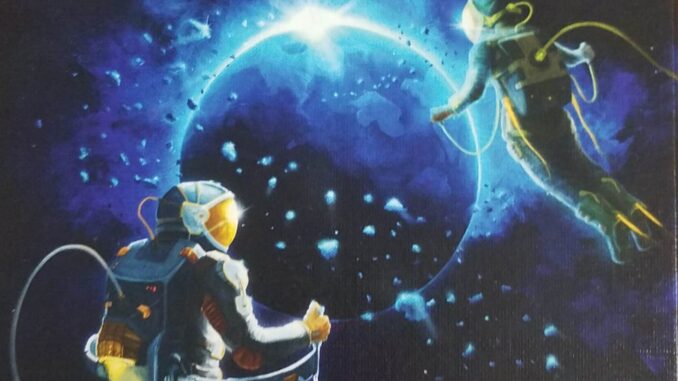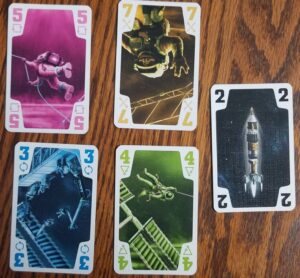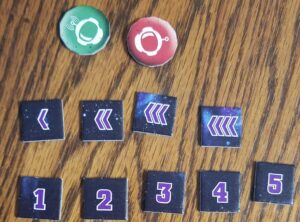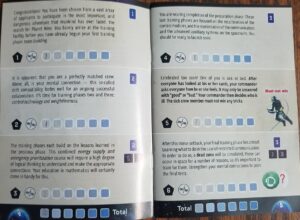
Do you like games where you have to communicate but can’t talk? How about your card counting skills? Are they up to snuff? The Crew will test both.
Gameplay- B+

This is a game that is both incredibly simple and complicated at the same time. At the core, it is a trick taking game. Every round, each player will play a card from their hand. The cards are number 1-9 from four colored suits. The first player’s card determines the lead suit. If another player has a card of that suit they must play it, otherwise, they can play any of their cards. Whomever has the high card, wins the trick. There are also four Rocket cards, number 1-4, which act as trump cards.
The game is called The Crew for a reason. It is a cooperative game. The players must work together to ensure the right person is the one who takes each trick. It is intended to be played over a campaign, with each round becoming more complicated. Each scenario has different rules that will come into effect for that game (called a mission in the game’s theme). There is a secondary deck of cards matching the first. For a given mission, you will probably draw a number of cards from this deck and then assign them to each player, who must take the trick containing that card in order for the team to complete the mission. For example, you could get the purple 2 and therefore must win the trick where the purple 2 is played.
The trick (pun intended) is that the players are not allowed to communicate with each other. They must choose which mission card they think they can take and must play cards all without communicating. This can be problematic. If you need to take a particular card, say that aforementioned purple 2, and are the lead player, so play a purple 8. The next players obliges and plays the purple 2 so you can take it when you win the trick. However, the third player only has the purple 9 in their hand so must play it, winning the trick and causing the team to lose the game.

There is one exemption to the communication restriction. Each player has a green communication token. During the game they can use this token to reveal one card from their hand and then place the token on it. At the top, they communicate that it is their highest card of that color. In the middle, it means it is their only card of that color. And at the bottom, it is their lowest card of that color. They can only use the token once but when used strategically it can make all the difference. From the above example, if the player had communicated that the purple 9 was their only purple card, the first player would have had to figure out another way to acquire the purple 2.
Each scenario will be more complicated than the last. You’ll start out with one objective cards. These will slowly increase and more restrictions will come into play. Cards will have to be won in a certain order. Communication might be limited to just showing you have a card but not saying if it’s highest, lowest or your only card. In one scenario, we had to win no tricks with a 9 card, which proved difficult.
Production- A-

The cards are made from sturdy material, perfect for cards that need to be shuffled a bunch of times. The box comes with a divider that creates areas for the playing deck and the smaller mission deck. This helps them stay separated while in the box. There is also room for the cardboard tokens that you use to designate mission objectives and the commander. Only knock is said commander token. Assembled, it doesn’t quite fit in the box, so the lid doesn’t rest flat.
The campaign book and the rule book are one and the same. However, it’s easy to flip between the two because they are printed reverse. Half the book is instructions, flip it upside down and you have the campaign book. It’s a minor thing but a bit easier to find each than flipping to the back of standard book.

Theme- B-
There is technically a theme to the game. The flavor text before each mission lays out what you and your crew are doing. But really, it’s all window dressing. If you’re into the theme, you can read the text before each round. If you’re not, it doesn’t hinder the play experience at all to leave it out.
Expansions- TBD
None currently, but there is a sequel, in essence, called The Crew: Mission Deep Sea. From the description, it sounds like a very similar game, with some new twists on the missions and a different theme.
Conclusion- B+
This is a simple game to grasp the rules for but nevertheless, not a boringly simple game to play. Mission rounds go fast since as soon as you complete the objectives, or fail, you can stop. There’s not a slow slog to an inevitable conclusion. Figuring out how to complete each objective requires thinking carefully, as each attempt will be different due to different draws. This is one of the games downsides as well though. You can be dealt a hand that makes winning literally impossible.

Wayne Basta
Latest posts by Wayne Basta (see all)
- X-Wing Tier List – Rebels - May 10, 2023

